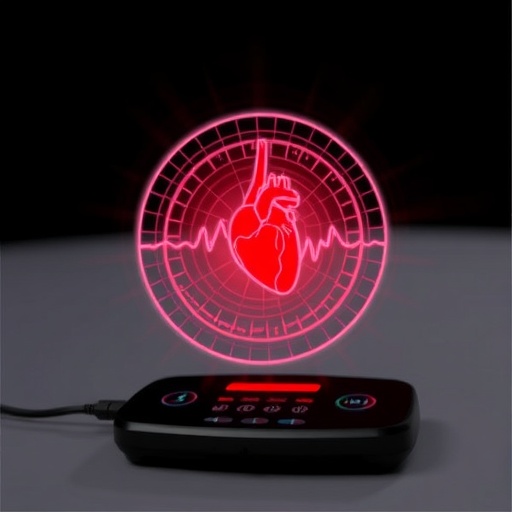In a groundbreaking advancement poised to transform cardiovascular health monitoring, researchers have unveiled a novel technique that leverages contactless radio frequency (RF) signals combined with sophisticated knowledge transfer algorithms to detect atrial fibrillation (AFib) with unprecedented precision. This innovative approach, detailed in a recent publication in Nature Communications, navigates the confluence of wireless technology, artificial intelligence, and medical diagnostics to enable unobtrusive, real-time cardiac rhythm monitoring beyond traditional clinical settings.
Atrial fibrillation, characterized by irregular and often rapid heart rhythms, is a prevalent cardiac arrhythmia affecting millions worldwide. It significantly elevates the risk of stroke, heart failure, and other cardiovascular complications. Current diagnostic methods largely rely on electrocardiogram (ECG) recordings, which necessitate direct skin contact via electrodes, limiting continuous monitoring due to patient discomfort or logistical constraints. The new RF-based modality disrupts this paradigm by harnessing ambient radio waves and advanced computational models to remotely sense cardiac activity without physical sensors attached to the body.
Fundamentally, the technique exploits the interaction between transmitted radio waves and the physiological movements of the chest and heart tissues. Radio signals emitted within the microwave spectrum reflect off the body and undergo subtle modulations corresponding to heartbeat-induced mechanical vibrations. By capturing and decoding these modulated signals, it becomes feasible to reconstruct rhythmic cardiac patterns indicative of atrial fibrillation episodes. This method circumvents the invasiveness of traditional tools, offering a passive and continuous monitoring solution suitable for home environments and clinical contexts.
Central to this innovation is the incorporation of knowledge transfer—a branch of machine learning wherein models trained on one domain or dataset are adapted to perform robustly on different but related domains. Given the variability inherent in radio signal propagation due to factors such as individual anatomy, environmental interference, and device orientation, conventional machine learning models trained on confined datasets often falter in real-world applications. The research team overcame this by designing transfer learning frameworks that generalize detection capabilities across diverse populations and environments, thereby ensuring reliable AFib identification regardless of patient-specific or contextual discrepancies.
The RF monitoring system integrates a network of antennas and sensors configured to emit and receive high-frequency signals. These signals penetrate clothing and ambient obstacles, enabling discreet cardiac motion tracking without impeding daily activities. Signal pre-processing techniques isolate cardiac-related features by filtering out noise and extraneous motion artifacts, enhancing the fidelity of the acquired data. Afterwards, a cascade of deep learning architectures interprets these features, distinguishing pathological AFib rhythms from normal sinus rhythms and other cardiac anomalies with clinical-grade accuracy.
Clinical validation of this approach entailed extensive testing on volunteer cohorts, encompassing both healthy individuals and patients with confirmed atrial fibrillation diagnoses. Comparative analyses against gold-standard ECG measurements demonstrated that the radio-based system exhibited sensitivity and specificity metrics exceeding 90%, rivaling or surpassing conventional wearable monitors. Furthermore, the non-contact nature of the method significantly improved patient compliance by eliminating the discomfort and inconvenience associated with adhesive electrodes and bulky wearable devices.
One profound implication of this study lies in its potential to reshape preventive cardiology and chronic disease management. By deploying RF monitoring devices in domestic or communal settings, healthcare providers can obtain continuous, long-duration cardiac surveillance data, enabling early detection of arrhythmic events that often go unnoticed until complications arise. This could foster a paradigm shift from episodic diagnostic visits to proactive, data-driven health maintenance, reducing hospital admissions and associated healthcare expenses.
Moreover, the seamless integration of knowledge transfer models signifies a stride towards personalized medicine. Instead of relying solely on population-wide training data, the system progressively adapts to individual physiological signatures, refining its predictive capabilities over time. This dynamic adaptability not only enhances diagnostic accuracy but also accommodates longitudinal monitoring where cardiac dynamics may evolve due to aging, medication, or lifestyle changes.
Beyond cardiac applications, the methodology opens avenues for broader biomedical sensing via radio technology. Contactless RF monitoring can extend to respiratory health assessment, sleep disorder detection, and rehabilitation progress tracking, all achievable in a non-invasive framework. The interdisciplinary collaboration central to this research, combining expertise from electrical engineering, computational science, and clinical cardiology, underlines the burgeoning role of signal processing and AI in reshaping healthcare landscapes.
Despite the promising results, the team acknowledges challenges ahead. Variations in household layouts, presence of multiple individuals, and other environmental interferences necessitate ongoing refinement of signal filtering and machine learning robustness. Privacy considerations surrounding continuous ambient monitoring also demand rigorous ethical scrutiny and data protection policies to safeguard user confidentiality and autonomy.
Looking forward, the researchers envision miniaturization and integration of RF hardware into ubiquitous consumer electronics such as smartphones and smart home assistants. Such scaling could democratize access to cardiac monitoring, embedding cardiovascular health checks seamlessly into daily life. Additionally, real-time data transmission paired with cloud-based analytics may facilitate remote clinical oversight, allowing physicians to intervene promptly upon detection of dangerous arrhythmias.
The convergence of contactless radio sensing and adaptive knowledge transfer exemplifies the future trajectory of personalized, non-invasive medical diagnostics. By transcending the limitations of traditional devices and unlocking continuous, convenient cardiac monitoring, this innovation stands to substantially mitigate the global burden of atrial fibrillation and related cardiovascular diseases. As the technology matures, it heralds a new era of smart healthcare, where invisible waves safeguard visible health.
Subject of Research: Atrial fibrillation detection using contactless radio frequency monitoring enhanced by knowledge transfer machine learning techniques.
Article Title: Atrial fibrillation detection via contactless radio monitoring and knowledge transfer.
Article References:
Yuan, Y., Chen, J., Zhang, D. et al. Atrial fibrillation detection via contactless radio monitoring and knowledge transfer. Nat Commun 16, 4317 (2025). https://doi.org/10.1038/s41467-025-59482-y
Image Credits: AI Generated




